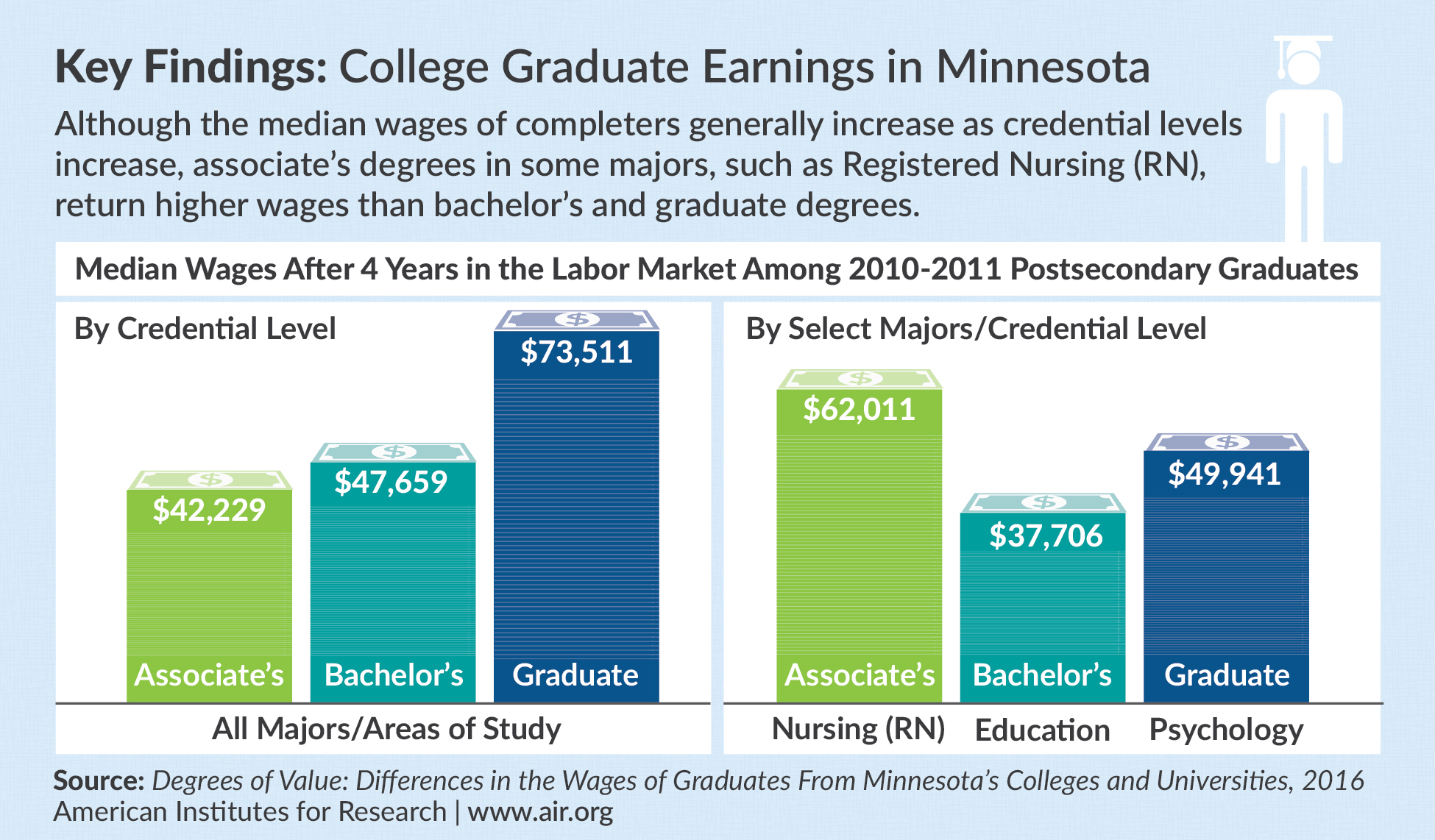In Minnesota, Majors Matter, AIR Study Finds; Future Earnings Linked to College Course of Study
Washington, D.C. – Majors matter. That simple mantra is sound advice for Minnesota students as they prepare for college and the workplace beyond.
A new report conducted for the Minnesota Office of Higher Education by College Measures, a division of the American Institutes for Research (AIR), examines the salaries by major of graduates up to four years after they get degrees or certificates from Minnesota public colleges and universities.
“As the cost of higher education increases, so does the pressure on students to choose a major that will lead to a good-paying job,” said Commissioner Larry Pogemiller, Minnesota Office of Higher Education (OHE). “This website offers data-based trends specific to Minnesota that can help students and families make informed decisions.”
“As a nation, we are fixated on the reputation of certain top-tier schools” said Mark Schneider, a vice president and Institute Fellow at AIR. “But in terms of return on investment, there is far less variation across graduates than one might expect. Choice of major has a far more dramatic impact on what students earn after graduation than where they go to college.”
The report’s associated website, Education Pays for Minnesota, allows prospective students to engage in a deep investigation into the wages of graduates from different majors throughout the state. For example, they may compare the wages of graduates from every psychology program in every public and many private universities in Minnesota, or compare the wages of graduates with degrees in different majors (sociology or math, for example) at a single institution, like the University of Minnesota, Twin Cities. Similarly fine-grained data can be found at different credential levels, allowing a comparison of wages earned by students in, say, mathematics at the associate's, bachelor’s and master’s degree levels.

A consistent theme of the report is the disconnect between the popularity of certain majors and future earnings potential. For example, psychology is one of the most popular majors in Minnesota. Yet even the median wage of the highest paid graduates with bachelor’s degrees in psychology, those who attended Argosy University/Twin Cities, was lower than the statewide median for all graduates with bachelor’s degrees—by nearly $2,000. Graduates with bachelor’s degrees from nearly every one of the psychology programs in the state had median wages that were lower than the median wages of all graduates with associate's degrees, regardless of major.
A similar trend can be found at the master’s degree level. Median wages of those who earned graduate degrees in social work ranged from less than $45,000 (St. Cloud University)—which is only $2,000 more than the statewide median wage for all graduates with associate's degrees and almost $3,000 less than the statewide median wage for all graduates with bachelor’s degrees—to about $54,000 (Augsburg College), which is almost $20,000 less than the median wage for completers of all graduate degrees.
By contrast, graduates in many health-related majors earn higher wages, as do technicians at nearly every level of higher education. Despite a push to increase the education of nurses, requiring them to have a bachelor’s degree, graduates with an associate's degree in nursing are well rewarded in the job market, earning a median income of $62,011, well over the statewide median for all bachelor’s degree programs, $47,659. Students who earned a bachelor’s degree in nursing are among the highest paid graduates, earning about twice as much as the lowest paid graduates—those with bachelor’s degrees in fine arts.
The report also found that the shortage of graduates in STEM (science, technology, engineering and mathematics) fields does not translate uniformly into higher wages for graduates in these fields. For example, biology is by far the largest STEM program in the state. However, the wages of graduates with bachelor’s degrees in biology were about $4,000 lower than the statewide median wage for all graduates with bachelor’s degrees. But graduates with bachelor’s degrees in mathematics had the third highest median wages among the largest programs, around $9,000 more than all graduates with bachelor’s degrees.
“In short, higher education usually pays—but far more for some graduates than for others,” Schneider said.
Pogemiller cautions, however, that while this data is important, it only reflects one aspect of the value of postsecondary education.
“The benefits of some degrees in terms of earnings may not become evident for as many as ten years after completion,” said Pogemiller. “There are also important social and critical thinking skills learned in college that are needed to solve the increasingly complex problems our world faces. Our democratic system relies on an educated populace.”
Degrees of Value: Differences in the Wages of Graduates from Minnesota’s Colleges and Universities is available at www.air.org.
About AIR
Established in 1946, with headquarters in Washington, D.C., the American Institutes for Research (AIR) is a nonpartisan, not-for-profit organization that conducts behavioral and social science research and delivers technical assistance both domestically and internationally in the areas of health, education, and workforce productivity. For more information, visit www.air.org.
###